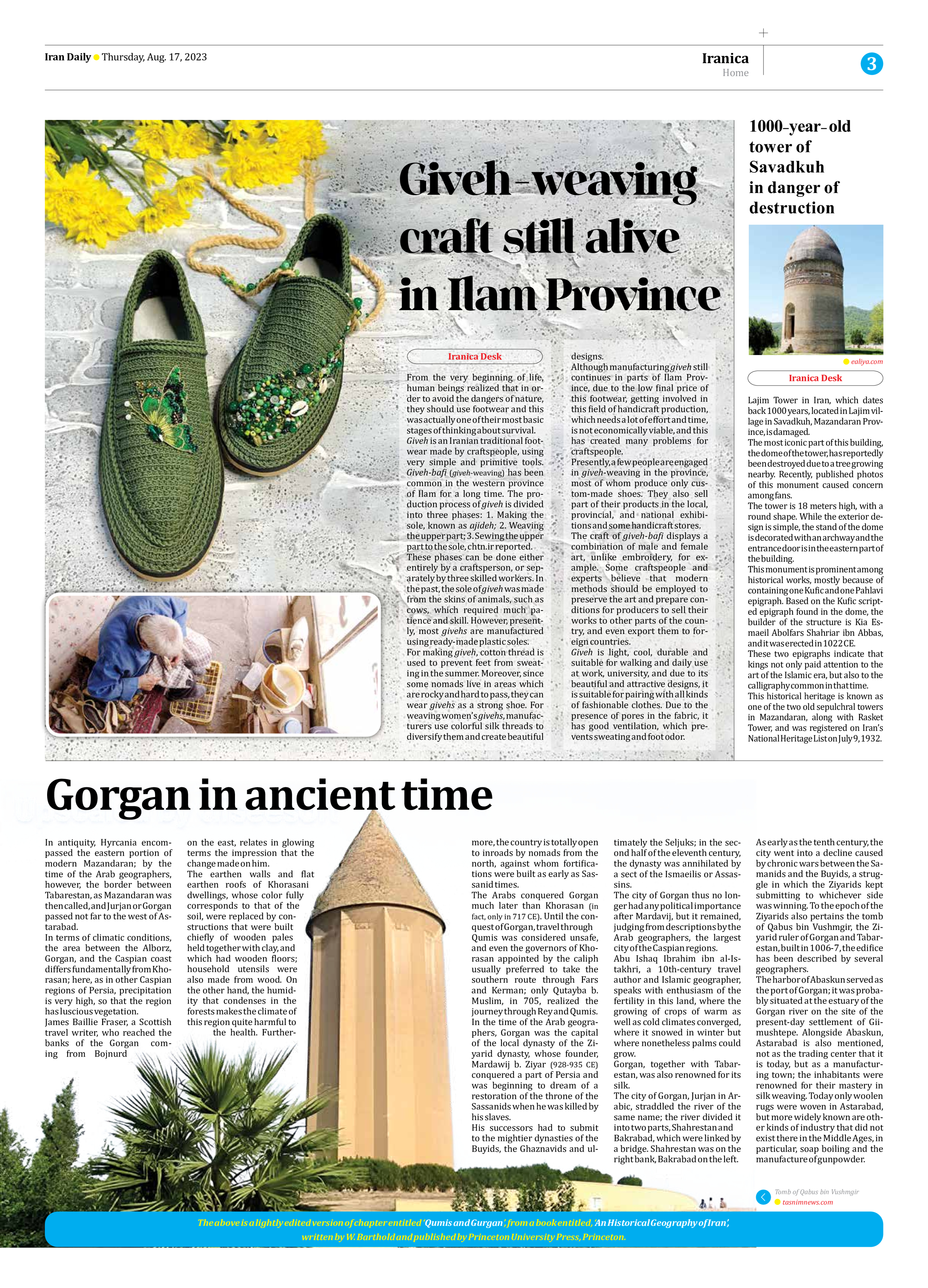
Gorgan in ancient time
In antiquity, Hyrcania encompassed the eastern portion of modern Mazandaran; by the time of the Arab geographers, however, the border between Tabarestan, as Mazandaran was then called, and Jurjan or Gorgan passed not far to the west of Astarabad.
In terms of climatic conditions, the area between the Alborz, Gorgan, and the Caspian coast differs fundamentally from Khorasan; here, as in other Caspian regions of Persia, precipitation is very high, so that the region has luscious vegetation.
James Baillie Fraser, a Scottish travel writer, who reached the banks of the Gorgan coming from Bojnurd on the east, relates in glowing terms the impression that the change made on him.
The earthen walls and flat earthen roofs of Khorasani dwellings, whose color fully corresponds to that of the soil, were replaced by constructions that were built chiefly of wooden pales held together with clay, and which had wooden floors; household utensils were also made from wood. On the other hand, the humidity that condenses in the forests makes the climate of this region quite harmful to the health. Furthermore, the country is totally open to inroads by nomads from the north, against whom fortifications were built as early as Sassanid times.
The Arabs conquered Gorgan much later than Khorasan (in fact, only in 717 CE). Until the conquest of Gorgan, travel through
Qumis was considered unsafe, and even the governors of Khorasan appointed by the caliph usually preferred to take the southern route through Fars and Kerman; only Qutayba b. Muslim, in 705, realized the journey through Rey and Qumis.
In the time of the Arab geographers, Gorgan was the capital of the local dynasty of the Ziyarid dynasty, whose founder, Mardawij b. Ziyar (928-935 CE) conquered a part of Persia and was beginning to dream of a restoration of the throne of the Sassanids when he was killed by his slaves.
His successors had to submit to the mightier dynasties of the Buyids, the Ghaznavids and ultimately the Seljuks; in the second half of the eleventh century, the dynasty was annihilated by a sect of the Ismaeilis or Assassins.
The city of Gorgan thus no longer had any political importance after Mardavij, but it remained, judging from descriptions by the Arab geographers, the largest city of the Caspian regions.
Abu Ishaq Ibrahim ibn al-Istakhri, a 10th-century travel author and Islamic geographer, speaks with enthusiasm of the fertility in this land, where the growing of crops of warm as well as cold climates converged, where it snowed in winter but where nonetheless palms could grow.
Gorgan, together with Tabarestan, was also renowned for its silk.
The city of Gorgan, Jurjan in Arabic, straddled the river of the same name; the river divided it into two parts, Shahrestan and
Bakrabad, which were linked by a bridge. Shahrestan was on the right bank, Bakrabad on the left.
As early as the tenth century, the city went into a decline caused by chronic wars between the Samanids and the Buyids, a struggle in which the Ziyarids kept submitting to whichever side was winning. To the epoch of the Ziyarids also pertains the tomb of Qabus bin Vushmgir, the Ziyarid ruler of Gorgan and Tabarestan, built in 1006-7, the edifice has been described by several geographers.
The harbor of Abaskun served as the port of Gorgan; it was probably situated at the estuary of the Gorgan river on the site of the present-day settlement of Giimushtepe. Alongside Abaskun, Astarabad is also mentioned, not as the trading center that it is today, but as a manufacturing town; the inhabitants were renowned for their mastery in silk weaving. Today only woolen rugs were woven in Astarabad, but more widely known are other kinds of industry that did not exist there in the Middle Ages, in particular, soap boiling and the manufacture of gunpowder.
The above is a lightly edited version of chapter entitled ‘Qumis and Gurgan’, from a book entitled, ‘An Historical Geography of Iran’,
written by W. Barthold and published by Princeton University Press, Princeton.







